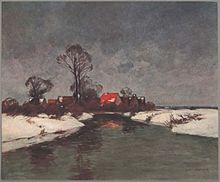Carl Küstner
Carl Küstner (born November 15, 1861 in Guntersblum , † June 18, 1934 in Munich ) was a German painter and art professor .
Life
Carl Küstner was born in 1861 as the son of a farmer , Johannes Küstner II, and a housewife , Helene Küstner. He grew up in Guntersblum, Rhineland-Hesse , where he also attended the elementary school that was later named after him. Then his further way to school led to Worms . Here he attended a secondary school before starting a commercial apprenticeship.
When he was finally called up for military service in Munich , and he was classified as unfit , he discovered his passion for nature and painting. As a result, he later moved to Geneva , where he began to create his first works. When he returned to Munich in 1884 to present his works to the recognized landscape painter Professor August Fink , the latter immediately discovered his talent . Now Carl Küstner became his student for six years. During this time he developed his own style and also learned to paint more professionally. As early as 1889, his works were presented to the international public at the international art exhibition in the Munich Glass Palace . In 1900 he finally married Tusnelda Fink from Stuttgart . From this marriage a daughter was born. A year later he built his summer studio in Guntersblumer Kellerweg .
In 1927 Carl Küstner, who was now deeply integrated into Munich's artistic life, was appointed Professor of Fine Arts .
Later his works became more and more famous, so that some of his works were exhibited in the Deutsches Museum and the Neue Pinakothek in Munich in the 1930s . All in all, his works were exhibited in Munich until 1934, a total of 45 years - a rarity.
In 1932 he was in his hometown for the last time before a severe thyroid disease prevented him from traveling from Munich to Guntersblum. He finally died on June 18, 1934 in Munich.
plant
Painting style
Carl Küstner preferred to paint his pictures wide, firm and juicy in strong and full colors. The color scheme of his pictures was often based on the triad of green, light blue and red.
Motifs
Carl Küstner always preferred his homeland in his pictures : He often painted the Rhine-Hessian landscape , the Old Rhine in Rheinhessen and the Hessian Ried . Also is winter and the thaw often called motif found in his paintings. The titles of his works are called Dorf an ein Bach , Am Altrhein , Abend am Fluss , Herbstwald , bei Rettenberg im Allgäu or Winterabend .
Exhibitions (selection)
- 1887: Hamburg spring exhibition , Isar motif near Lenggries
- 1888: Munich Glass Palace, summer morning
- 1889 and 1891: Autumn exhibition in Munich
- 1890: Annual exhibition in Vienna, autumn morning
- 1890: Bremen general art exhibition, autumn evening , spring , summer , trees by the water
- 1893 to 1934: Munich Glass Palace
Honors
- 1897: 2nd class medal from the jury of the Munich art exhibition
- 1901: Gold medal 1st class for his picture Winter Evening
- 1902: Silver or small gold state medal in Vienna for the Buchenwald oil painting
literature
- Küstner, Karl. In: Friedrich von Boetticher: painter works of the 19th century. Contribution to art history. Volume 1/2, sheets 31–61: Heideck – Mayer, Louis. Ms. v. Boetticher's Verlag, Dresden 1895, pp. 794-795 ( archive.org ).
- Küstner, Carl . In: Hans Vollmer (Hrsg.): General lexicon of fine artists from antiquity to the present . Founded by Ulrich Thieme and Felix Becker . tape 22 : Krügner – Leitch . EA Seemann, Leipzig 1928, p. 77 .
- Fritz von Ostini : Munich Art. Leipzig 1906, p. 17.
Web links
- Information about Carl Küstner on the website of the Guntersblumer Kulturverein
Individual evidence
- ↑ Illustrated catalog of the international art exhibition in the Königigl. Glass palace in Munich . Munich 1883, p. 75 ( Textarchiv - Internet Archive ).
- ↑ Küstner, Karl. In: Friedrich von Boetticher: painter works of the 19th century. Contribution to art history. Volume 1/2, sheets 31–61: Heideck – Mayer, Louis. Ms. v. Boetticher's Verlag, Dresden 1895, pp. 794-795 ( archive.org ).
- ^ Catalog of the 31 year exhibition in Vienna . Cooperative of Visual Artists Vienna, Vienna 1904, p. 12–13 and 45 ( Textarchiv - Internet Archive ).
| personal data | |
|---|---|
| SURNAME | Küstner, Carl |
| BRIEF DESCRIPTION | German painter and art professor |
| DATE OF BIRTH | November 15, 1861 |
| PLACE OF BIRTH | Guntersblum |
| DATE OF DEATH | June 18, 1934 |
| Place of death | Munich |



